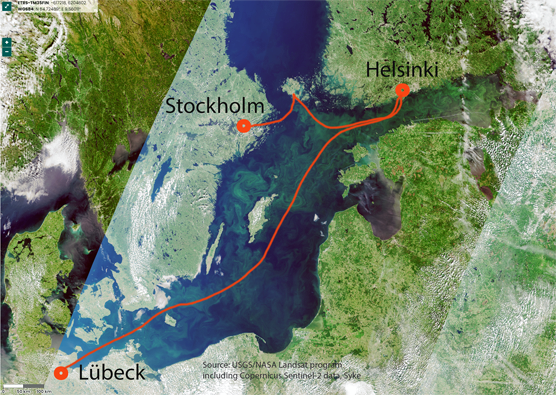
In the Alg@line monitoring network, the measurement route of Silja Serenade is between Helsinki and Stockholm, and the route of Finnmaid is between Helsinki and Lübeck. Source: USGS/NASA Landsat program including Copernicus Sentinel 2 data, Syke.
The Alg@line monitoring network, which automatically tracks the condition of the Baltic Sea, has been operational for over thirty years. Coordinated by the Finnish Environment Institute, the Alg@line network integrates commercial maritime traffic with real-time scientific observations. Measurement equipment on the Silja Serenade and Finnmaid vessels collects crucial monitoring data for marine protection, research, and maritime needs.
The Alg@line monitoring network provides a comprehensive regional and temporal picture of the state of marine areas to decision-makers and citizens. The results are used to monitor, in particular, algal blooms, temperature, nutrient status, and greenhouse gases in the sea. The network thus supports marine spatial planning and the evaluation of emission reductions and cost-effective measures. Observations of the network are important for maritime traffic for predicting ice cover and weather conditions.
“Observations from the sea surface layer provide very important comparative data for marine modelling and satellite observations,” emphasises Jukka Seppälä, Head of Group at the Finnish Environment Institute.
The monitoring network produces real-time monitoring data from almost the entire Baltic Sea, as Swedish, German, and Estonian merchant ships are also involved in the cooperation.
Monitoring measurements are cost-effective and continuously evolving
The real-time observations are carried out with equipment installed on ships, known as Ferryboxes, which automatically collect data of seawater as it flows through them while the ship moves. These measurements are cost-effective and provide temporally and spatially dense observations.
The FerryBox measures salinity, temperature, the amount of chlorophyll (green pigment) of phytoplankton, turbidity, oxygen, pH, and the amount of cyanobacteria and dissolved organic matter. In addition, the equipment collects water samples for nutrient measurement along the route.
As technology advances, so do the measurements. Automatic imaging and artificial intelligence-based equipment have recently been tested on Finnmaid. These instruments have been used to identify phytoplankton, their species composition, and the dynamics of summer cyanobacterial blooms.
Greenhouse gas measurements aid in assessing the carbon balance of the Baltic Sea
In 2024, Silja Serenade, which operates between Helsinki and Stockholm, was included in the international ICOS network for measuring greenhouse gases. The Finnish Meteorological Institute uses these observations together with measurements done at the Utö Marine and Atmospheric Research station to evaluate changes in the carbon balance of the Baltic Sea.
“One of the most interesting research topics is the connection between terrestrial ecosystems and marine coastal areas. It is essential to determine what part of the carbon from land ends up in the seas via rivers and is further released into the atmosphere as greenhouse gases,” says Lauri Laakso, Head of Group at the Finnish Meteorological Institute.
International workshop promoted cooperation
The 30-year measurement activities of the Alg@line monitoring network were comprehensively presented at an international workshop held at the Finnish Meteorological Institute on 1-2 October 2024. European researchers exchanged information and experiences on new measurement techniques suitable for merchant ships, harmonisation of measurements, and the usability of data for various purposes.
Further information
Alg@line monitoring network and international cooperation:
Jukka Seppälä, Group manager, Finnish Environment Institute, tel. +358 295 251 631, firstname.lastname@syke.fi
Katri Kuuppo, Senior Researcher, Finnish Environment Institute, tel. +358 50 307 5964, firstname.lastname@syke.fi
Carbon dioxide measurements in seawater on the Silja Serenade and at the Utö research station:
Lauri Laakso, Group manager, Finnish Meteorological Institute, tel. +358 50 525 7488, firstname.lastname@fmi.fi
Martti Honkanen, Researcher, Finnish Meteorological Institute, tel. +358 40 041 8624, firstname.lastname@fmi.fi